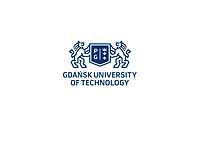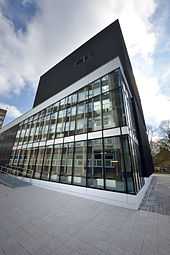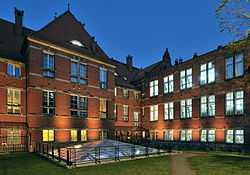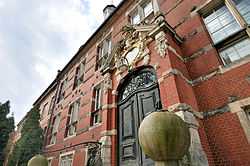Gdańsk University of Technology
| Gdańsk University of Technology | |
|---|---|
| Politechnika Gdańska | |
 | |
| Motto | "History is wisdom - future is challenge" - the new motto of the university adopted by the resolution of the Senate of Gdańsk University of Technology on January 21, 2015 |
| Established | 1904 |
| Type | Public |
| Rector | Henryk Krawczyk |
| Students | 26,000 |
| Location | Gdańsk, Poland |
| Website | www.pg.edu.pl |
 | |
Coordinates: 54°22′17″N 18°37′8″E / 54.37139°N 18.61889°E
The Gdańsk University of Technology (Polish: Politechnika Gdańska) is a technical university in Gdańsk-Wrzeszcz, and one of the oldest universities in Poland. It has nine faculties and with 41 fields of study and more than 26 thousand undergraduate, as well as about 400 doctoral students. It currently employs 2500 people, including 1200 academic teachers. The rector of the university is professor Henryk Krawczyk.
Some degree courses and various specialisations are taught in English. Moreover, some of the courses offered by GUT are unique in Poland, for instance ones in Construction Chemistry, Nanotechnology, Geodesy and Cartography, as well as Engineering of Natural Resources.
Students have access to specialist laboratories, lecture theatres with multimedia facilities, a library with 1.2 million volumes and various sports facilities. Undergraduates can also join one or more of 60 student science or language societies as well as other organisations.
During the recent years, Gdańsk University of Technology has made many changes, both preserving the tradition of a technical university and being open for economic and social demands. University is now facing transformation: from a digital university into a SMART university, realizing new international projects and innovative incentives.
Great emphasis is placed on maintaining high education quality standards – GUT is the second Polish institution of higher education to hold the prestigious ECTS Label. GUT is also the first and only Polish university to be a member of the CDIO Initiative, founded by the Massachusetts Institute of Technology in collaboration with Chalmers University of Technology in Sweden. CDIO aims to provide an education for engineers that enables them to “Conceive, Design, Implement and Operate” pro-industrial technological systems.
Active member of a number of university networks and associations, e.g. Baltic Science Research (coordination of nanotechnology research and education), Baltic University Network (Uppsala Protocol) and the Baltic Sea Region University Network.
History
The university was founded in 1904 as Königliche Technische Hochschule zu Danzig. At the time Gdańsk, then known as Danzig, was part of the German Empire. The history of Gdańsk is complex and the city itself belonged, at different times to Poland and Germany. In the interwar it had become "free city". The names of the city's educational institutions were affected by the changes in the city status. The university was known by different names:
- 1918–1921: Technische Hochschule in Danzig (Wyższa Szkoła Techniczna w Gdańsku)
- 1921–1939: Technische Hochschule der Freien Stadt Danzig (Wyższa Szkoła Techniczna Wolnego Miasta Gdańska)
- 1939–1941: Technische Hochschule Danzig
- 1941–1945: Reichshochschule Danzig
In the late 1930s, Polish students were subject to discrimination by German teachers, many of whom had joined the NSDAP Nazi Party. Following the outbreak of World War II, Polish students were expelled from the university. Instructors who were members of the NSDP taught classes in uniforms of the Nazi party and began each class with a Hitler salute. Toward the end of the war, the university was turned into a German army hospital. When the Soviet Red Army captured the university/hospital, Russian soldiers shot dead some of the Germans and then closed all exits to the main building and burned alive the remaining wounded German soldiers. The Russians arranged stables and barracks in other buildings. In 1945, all Germans were expelled from the city of Gdansk and the burned ruins were turned into a Polish university (24.05.1945). In light of tragic history of the university under Nazi rule, today's university officially does not continue traditions of pre-war schools and its history starts in 1945.[1]

The school was reorganized and rebuilt under the supervision of Stanisław Turski, a Polish mathematician and former inmate of German concentration camps. Turski also served as the first post-war rector of the university.
Important dates in Gdansk University of Technology history:
1900 – the cornerstone is laid for the university building
1904 – King’s Technical High School is created
1941-1945 – the university is subordinated to the nazi Germany
1945 – on May 24, the university became a Polish state academy
2004 – 100-year anniversary of founding a Gdansk University of Technology
2014 – 110-year anniversary of founding a Gdansk University of Technology
2020 – Smart University
Location
Gdansk University of Technology (GUT) is located in Gdańsk – a city of more than 1000-year old tradition, situated at the mouth of the Vistula River on the Baltic Sea. Much of the city’s industry is related to shipbuilding and shipping.
Gdańsk is the capital of the Pomeranian region and has nearly 500 000 inhabitants. There are numerous higher education institutions located in the region. Among this quite considerable group, Gdańsk University of Technology is the largest technical university and the oldest technical university in Poland.
Patrons
Johannes Hevelius (1611-1687) created the first world's great astronomical observatory equipped with telescopes. Hevelius was also a physicist because he discovered centuries old changes in magnetic declination. He was technician too, because he constructed Poland's first pendulum clock, conceived, designed and built the first world's periscope, as well as the first micrometer screw which belongs today to the Gdańsk City Council.
Daniel Gabriel Fahrenheit (1686-1736) was born in Gdańsk. He is mainly known for being the first to use mercury in temperature measuring devices (previously alcohol was used) and developed his own scale of 0 to 212 degrees.
Hevelius and Fahrenheit, the two distinguished physicists who are considered as representatives of Polish science, have their own places of rembrance at Gdańsk University of Technology. By virtue of the Resolution of the Senate, the Courtyards in the Main Building of Gdańsk University of Technology have been named after the two scientists. Both of them has been commemorated with a reliefs, that have been designed by the scientists of Gdańsk University of Technology due to genetic algorithm and a specially designed computer application running on GUT's supercomputer.
Campus
The university campus consists of many buildings built with various architectural styles over the last one hundred years. The monumental Main Building designed at the beginning of the 20th century in the Dutch Neo-Renaissance style by Albert Cersten - an architect and a university professor - is the symbol of the university.
During the second world war 60 percent of the building and 70 percent of its roofing got burnt. The steel framework was the only remains of the clock tower. The damages were rebuilt but the decision on the tower reconstruction was put off many times. It was rebuilt on the Main Building 13 May 2012.
The campus of the Gdańsk University of Technology is continuously being developed. Elegant, modern, and eco-friendly buildings co-exist with charming and majestic edifices. Classes take place in modern auditoriums and well equipped specialised laboratories.
There are following modern educational and research centers along with supporting units within the university campus:
- Nanotechnology Centre with 25 modern laboratories equipped with unique devices for tests and level of atoms [2]
- LINTE^2 Laboratory of Innovative Electrical Power Technologies and Integration of Renewable Energy Sources.

- Maths and Distance Learning Centre that uses modern ICT technologies and tools for mathematical modeling and visualization of data.
- ICT Educational and Research Centre [3]
thet collaborates with over 100 companies in Pomerania and their partners in Kuyavia and Mazovia regions.
- Academic Sports Centre – sports facilities accessible to all students and employees: two swimming-pools: 25 m and 12,5 m; a full size football pitch 64m x 105m; a sports hall, a volleyball pitch, outdoor tennis courts; a fitness gym, bodybuilding gyms, a rowing gym, and a judo gym.
Gdańsk University of Technology has a modern student housing estate, which accommodates more than 2,500 people in 11 dormitories located in three attractive locations in the city.
SMART University (GUT's strategy)
- Strategically determined - raising funds to realise strategic goals, in accordance with the priorities and undertakings of the EU, Poland, and the region`
- Maximally innovative - implementing new mechanisms and taking the advantage of organisations that stimulate the development of innovative solutions, both for GUT and the region`
- Attractive to all - designing and introducing LLL solutions, using team approach to project and e-learning in the studies syllabuses, modernisation of educational and research laboratories, focus on practical application of research`
- Refining personality - creating a positive environment for the development of all students, doctoral students, and employees, particularly the best students, through setting ambitious tasks and rewarding significant results`
- Teamworking with passion - gradual removing of barriers and administrative obstacles, favouring verified models, nourishing the culture of work and innovation friendly environment`
Engineer of the Future
Gdańsk University of Technology has won the competition for EU funds to implement the Engineer of the Future project. The project proposes a new model of education focused on team designing and acquiring skills such as efficient collaboration, undertaking risk, or analytical problem solving. The funds raised will be spent on infrastructure modernisation and new laboratories.
Scientific research
- 300 inventions ready for implementation
- 200 research and development projects currently carried out
- 800 agreements with entrepreneurs concluded in last 3 years
There are high-investment projects carried out under the MAESTRO programme, the Applied Research Programme, the LIDER programme, the INNOTECH programme and the new GRAF-TECH programme. Outstanding students carry out their projects at the university within Diamond Grant programme.
Recent achievements at GUT

Cyber-eye
A cyber-eye can help people who fall into a coma. The device consists of an infrared camera and a special program that reads the eyeball movement. The cyber-eye allows to follow the place on the computer screen which the user observes. Thanks to it the patient can inform that he is thirsty or that a window needs to be opened. The authors of the system won the “Polish Innovation 2013” competition organized by the Ministry of Science and Higher Education. The invention is a part of the series of types of computer multimodal interfaces project.[4]
MEDEYE
Within 15 minutes it indicates a suspicious fragment in the recording where there may be an ulcer, bleeding, a polyp or another disease. It sends information about the completed analysis by text message or by email. A system to support the diagnostic endoscopic examination of the human digestive tract named MEDEYE has been designed to make the work of a physician more efficient. It analyses and interprets the image from a tiny camera closed in a capsule. Thanks to the MEDEYE the physician does not have to watch several-hourlong recordings but can concentrate on the fragments indicated by the system.
Domestic assistant
A domestic assistant for the elderly and ill people consists of a set of devices that discretely monitor the patient during his daily activities. The assistant collects information thanks to various sensors. In the case when the collected data substantially differs from the norm, the system alarms the physician or the person who takes care of the patient. Several devices were designed under this project and include an e-bathtub that monitors the patient taking a bath, an e-blanket that monitors the heart function of the patient sitting in an armchair and an e-blowpipe for rehabilitation in the case of facial nerve paralysis.
Medicine for osteoporosis
Most medicines available on the global market which contain alendronate sodium contain a biologically active substance manufactured by Polpharma SA basing on the technology developed at Gdańsk University of Technology. A single pack of Ostemax 70 comfort that contains 4 pills costs 25-30 PLN. In 2013 Polpharma SA was awarded the President of the Republic of Poland's Award for Innovation in recognition of its work on innovative technologies and launching a series of substances used for osteoporosis treatment.
NOR-STA Platform
The NOR-STA Platform is a platform of innovative software services facilitating achieving and assessing conformance to norms and standards – including hospital accreditation, CAF (Common Assessment Framework), information security management systems and HACCP standards. The users of the platform indicate its following major advantages: improved document management, retaining conformance, support for decision making process and time saving. This solution was awarded with the Gold Medal - Consumer Choice at the Poznań International Fair.[5]

Gesture-controlled Sound Mixing System
Solutions for remote computer set operations through gestures; was awarded gold medal at the Convention of the Auto Engineering in Rome.
Computer aroma interface
A product designed for people with developmental disabilities (intellectual disabilities, autism) and sensory deficits. In addition, the interface can be used in educational programmes, e.g. using odours emitter during the course of biology and materials science. The product has been awarded a gold medal at the Convention of the Auto Engineering in Rome.
Interface to synchronize the hemispheres of brain
The aim of the tool is to support the treatment of dyslexia, developmental and sensory disorders and to accelerate the pace of learning (including foreign languages acquisition). The invention received the gold medal of the Korean Association of the Inventors; silver medal at the VI International Exhibition of the Inventions IWIS 2012 and honorable mention at 8th Industrial Technology, Science and Innovation Fair TECHNICON-INNOVATION.
A set of hardware and software to support and develop the process of speech understanding in pupils
the device is designed to support the teacher’s speech recognition (during lessons and form recordings) and to assist the diagnosis of disorders (through computer programmes). Moreover, the product allows to adjust the parameters of the receiver to the real needs of the child and to train the ability to understand speech and to monitor process in this area through the included set of tasks for self-training. An important part of the solution is the algorithm for slowing down the speech during its reception. The hearing aid for patients with disorders of the central nervous system received a gold medal at the 60th edition of the World Exhibition of the Innovations, Research and the New Technologies BRUSSELS INNOVA 2012.
Auditory - Visual Attention Simulator
The interface will support people with disabilities of eyesight and hearing, as well as children with ADHD, as a multimedia stimulator of binocular vision in cases of “amblyopia” (“lazy eye” syndrome). An original application is a set of tools and tests to diagnose degree of awareness of persons with no contact (in coma or vegetative state); the interface was awarded gold medal of the Poznań International Fair within the competition Economy for Science, and was also awarded with the international exhibition of inventions BRUSSELS INNOVA 2012.[6]
Faculties

Mechanical Engineering
- Mechatronics
- Power Engineering
- Material Engineering
- Mechanical-Medical Engineering
- Mechanical Engineering and Machine Building
- Management and Production Engineering
Civil and Environmental Engineering
- Civil engineering (structural engineering, construction engineering)
- Environmental engineering
- Transportation engineering
- Geodesy engineering and Cartography

Architecture
- Architecture and Urban planning
- Spatial Development
Electronics, Telecommunications and Informatics
- Information Technology
- Biomedical engineering
- Electronic and Telecommunications engineering
- Automation and robotics engineering
Ocean Engineering and Ship Technology
- Ocean Engineering
- Transport
- Power Engineering

Management and Economics
- Economic Analytics
- European Studies
- Cognitive Engineering in Management and Economics
- Management
- Engineering Management
Chemistry
- Biotechnology
- Chemistry
- Environmental Protection Technology
- Chemical Technology
- Construction Chemistry
- Materials Conservation and Degradation
- Material Engineering

Applied Physics and Mathematics
- Technical Physics
- Mathematics
- Nanotechnology
- Basics of Technical Sciences
- Material Engineering
Electrical and Control Engineering
- Automatic Control and Robotics
- Electrical Engineering
- Power Engineering
International cooperation
Gdańsk University of Technology takes part in the European ERASMUS programme: Erasmus Plus, LLP Erasmus, LLP Erasmus Intensive Programs, Erasmus Mundus, Jean Monnet, CEEPUS, TEMPUS and Leonardo da Vinci.
Number of foreign students and visitors from all over the world grows year after year. In year 2013/2014 GUT hosted over 400 international students who chose one of 14 study programs taught fully in English at 9 faculties. The biggest groups of international students come from: Spain and China.
GUT participates in activities of IRO's Forum and the Baltic Sea Region University Network, whose purpose is to exchange experiences between universities in the fields of: internationalization of universities, exchange of students, intercultural communication, joint degree programs, internationalization at home or promotion abroad.
Languages students can learn at GUT
- English
- German
- French
- Spanish
- Italian
- Russian
- Swedish
- Japanese
- Hindu
- Polish[7]
Centre of Knowledge and Entrepreneurship
Gdańsk University of Technology cooperates with the world of business on various planes, and its relationship with the economic community is continually developing. Since March 2009 the university has had its own Centre of Knowledge and Entrepreneurship (CWiP), where business people and scientists can meet.
Thus innovative ideas reach those who are able to implement them and scientists obtain a better understanding of what the market needs. The Centre collaborates with many enterprises and represents them in dealings with, for instance, the Pomeranian Development Agency, Pomeranian Business Council, Pomerania Special Economic Zone, science and technology parks, other universities, Pomerania Regional Chamber of Commerce, Gdańsk International Fair, and various economic councils. Through this Centre GUT particularly wants to help small and medium-sized enterprises.
Support will also be provided to students and graduates who want to start their own business activities. Moreover, the Centre acts for the protection of intellectual property. In addition to this, the university makes numerous contracts concerning student internships and work experience. Leading firms in the Pomeranian region provide research grants and scholarships to the most talented students, as well as awarding prizes for the best diploma works and doctoral theses.
The best known figures in business participate in student debates, give lectures or provide training in self-presentation or company management. The university organises conferences with the participation of business people. For several years now Gdańsk University of Technology has been participating in the Technicon Innovations Science, Business and Industry Fair, during which a broad range of the newest inventions and their implementations is presented. Annual participation in this fair has resulted in the awarding of many prizes, including ones from competitions for the best innovations and technological solutions. The inventions of GUT students and staff have also been awarded prizes at international fairs.[8]
GUT’s Computer Network

The Tri-City Academic Computer Network (TASK) is one of the largest urban internet networks in Poland. It has been operating since 1992 thanks to an agreement reached between the Tri-City’s chief institutions of higher education. Gdansk University of Technology has played the leading role in constructing this metropolitan network. The initial plan was for it to primarily serve all schools of higher education as well as local branches of the Polish Academy of Sciences. Currently TASK is being prepared to include all schools in Gdańsk, of which there are over hundred. Entrusted with the management and expansion of this metropolitan network is the TASK Computer Centre, which was set up at Gdansk University of Technology in 1994. Today it is based in the new Faculty of Electronics, Telecommunications and Informatics building. As one of the five supercomputer centres in Poland, it provides the scientific community with processing resources in the form of high speed computers and specialist software. These resources help in the development of various fields of knowledge, for example: chemistry, physics, engineering, electronics and oceanography. Presently, there are over 50 projects being realised using the supercomputers at the centre, concerning among others things: molecular modeling of nucleic proteins and acids; quantum chemistry calculations; research into the properties of nanomaterials; modeling wave motion, currents and rising storms in the Baltic Sea and the Bay of Gdańsk; research into Nordic Seas dynamics and also modeling the behavior of skeleton muscles. The TASK Computer Centre is co-creating a national PIONIER fibre-optic network for the scientific and information community, and is also actively participating in six projects of the so-called innovative economy: MAYDAY, Pl-Grid, PLATON, Pomeranian Digital Library, Integrated Oceanographic Data System and NEWMAN. Virtually all these projects help to create new jobs. The total value in the region of 300 million zlotys. At the start of 2008 the Centre installed Galera, a computer cluster with the theoretical computer power over 50 Tflops. Thanks to Galera, the TASK Computer Centre has become one of the world’s leading supercomputing sites. Galera is still listed among the world’s 200 fastest computers in the prestigious TOP 500 chart.[9]
Library
The Gdansk University of Technology Main Library is the oldest and largest technical library in Northern Poland. Among the libraries of the world it can boast unique collection of priceless manuscripts and old prints from the Danzing Research Society, which was founded in 1743, and donated its 30,000 – volume collection to this library in 1923. The library’s current collection includes over a million volumes, including textbooks, lecture notes, books on science and technology, Polish and foreign scientific journals, as well as technical and trade literature. Moreover, the library stores publications in electronic form, to which it provides access via an on-line database. Every year the collection is expanded by new Polish and foreign publications concerning all aspects of science and technology.

The library system is very modern. Students can find the book or journal they are looking for in an on-line catalogue together with up-to-date information and whether it can be borrowed or read only in the reading room. By using their personal internet accounts, they can also prolong the time they borrow publications. There are a total of 16 reading rooms, ten in faculty branches of the library including specialist reading reading rooms for: journals and databases, scientific information and norms, technology and trade literature, as well as a historical collections reading room. In 2008 the library opened one of the most modern reading rooms in the country, which among other things provides a self-service specialist literature lending and returning facility. Gdansk University of Technology also provides a digital library. Moreover, it is participating in the creation of the Universal Library, i.e. worldwide digital library, and is also the coordinator of the Pomerania Digital Library. This internet library will comprise digital reproductions of scanned historical documents (lettered and unlettered). The intention is to digitalize an estimated total of over 20 million pages form Pomeranian library collections. [10]
110th anniversary of GUT
Throughout the whole year 2014 the Gdańsk University of Technology celebrated 110 years of its existence. The official inauguration of the jubilee year was in January 2014. The ceremony was held during the public session of the Senate on the occasion of academic promotions. Exactly on the 110th anniversary of the first inauguration - October 6, 2014 - there was the jubilee inauguration of the academic year. It is worth mentioning that a number of eminent personalities, including President Lech Wałęsa, and Minister of Science and Higher Education Lena Kolarska-Bobinska were among the honorary committee of the jubilee.
References
- ↑ Józef Włodarski. "Technical University in Gdańsk in the years 1904–1945, official website of Gdansk Technical University". Józef Włodarski. Retrieved November 25, 2009.
- ↑ "Official Website of European Fonds: Nanotechnology Centre". Retrieved July 10, 2014.
- ↑ "Official Website of ICT Educational and Research Centre". Retrieved July 10, 2014.
- ↑ "A new means of communication: Cyber eye". Retrieved July 10, 2014.
- ↑ "NOR-STA Platform". Retrieved August 20, 2014.
- ↑ "Selected international and national achievements of GUT researchers and students" (PDF). Retrieved August 20, 2014.
- ↑ "Official Website of Language Centre". Retrieved August 20, 2014.
- ↑ "Official Website of Centre of Knowledge and Entrepreneurship". Retrieved August 20, 2014.
- ↑ "Tri-City Academic Computer Network (TASK)". Retrieved August 20, 2014.
- ↑ "Library of Gdansk University of Technology". Retrieved August 20, 2014.